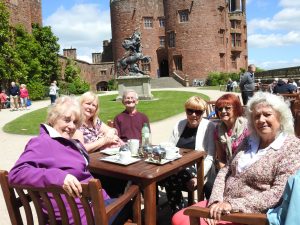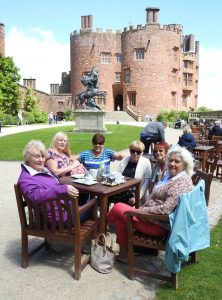This group visits National Trust properties. Contact for the group is Yvonne Carey, tel 01773 712 530.
There is a monthly meeting to discuss venues etc at the Dog and Parrot, Eastwood at 10.00 am.
National Trust visits will be made on different days and times, travelling to the site by coach. The cost will be for a seat on the coach and must be paid in full when booking.
Members are responsible for the cost of their entry to the National Trust property/site.
Gardens you can virtually tour while you are isolating.
Previous visits:
Charlecote Park – July 2023
On Wednesday 12th July the U3a National Trust Group visited Charlecote Park in Warwickshire. The weather forecast for the day predicted showers but we were lucky to have a warm dry day with lots of sunshine. Charlecote House is Elizabethan but the interior is Victorian with lots of lavish Victorian furniture.
The house itself is accessed down a long drive and through the Elizabethan gatehouse. Its unbelievable that we walked through the same gatehouse that Queen Elizabeth I entered the house nearly 500 years ago.
Although parts of the house was closed to visitors, the rooms that were open showed how the wealthy Victorians lived. The house was built and occupied by the Lucy family who are still in residence today.
In the afternoon the group discovered the wonderful parklands were deer and rare Jacobs sheep were either grazing or snoozing in the warm sun. Hard to imagine that a young William Shakespeare was once caught poaching in the park lands.
On our way out in the late afternoon we called at the family church which was open to visitors and had many memorials and tombs of the Lucy family. As you can see by the picture of the church interior, some of the tombs can be quite eye opening!
A wonderful day out and thanks go to Yvonne Carey for organising and choosing a lovely venue.
Roger Bacon
Wightwick Manor – September 2019
The National Trust Group had a wonderful visit to Wightwick (Wittick) Manor near Wolverhampton this month. The beautiful tudor manor was originally the home of the the Manders Family (paint manufacturers). It was full of interesting artefacts including paintings, stained glass, painted plaster reliefs and William Morris wallpapers.
We also enjoyed wandering around the large gardens full of flowers fruit and vegetables which many of us were able to purchase!! Weather was good too so an enjoyable day!!
Claire Booth
Quarry Bank
The N.T group had a very interesting and entertaining visit to Quarry Bank Cotton Mill in July. We were able to observe several of the machines working and producing fine cotton thread from raw cotton. Some of the machines filled almost the whole of the floor – (there were five floors altogether) and the noise was horrendous!!
We explored each floor, from the river and the water wheel that powered the machinery, to the top floor – all light and airy from the many windows in the mill. There were plenty of staff members who fully explained the workings of the machines and how the child apprentices spent their twelve hour shifts!
In 1790 the mill owner did provide a nearby house for the apprentices where they had a housekeeper to feed and care for them! The housekeeper actually showed us around and made us write on slates in the schoolroom! Greg (the owner) thought that if the apprentices were treated fairly, cared for and educated they would work harder! They also had a garden where fruit and vegetables were grown so the children were much better off than living in the workhouse where the majority were from!
There were lovely gardens and grounds to explore too but unfortunately the rain set in at the end of the day! Claire Booth
The national Trust Group took a coach trip of members to Quarry Bank near Manchester Airport on Tuesday 9th July 2019. Here we discovered how Samuel Greg founded his cotton empire and how the workers who toiled there experienced hardship and how the complex story of the mills need for power evolved . Most of us went on a guided tour of the Apprentices House which was very interesting. The family house was sparse, although in a grand setting of the grounds. Unfortunately the rain spoilt the garden and woodland walks, however the actual mill was brilliant with displays and machinery demonstrations on four levels. Also at river level the water wheel which originally was the hub of the driving force for the mill. This was a marvellous building with lots of interest and history for everyone and a really worthwhile visit. We all enjoyed the day and I would recommend a visit to others . Len Marsh
Erddig
The latest National Trust Group visit was to Erddig (pronounced Erthig), near Wrexham. It is a Grade I listed building and is one of the country’s finest stately homes. The house is famous for how the family treated their servants, with a display of portraits, photographs and verses lining the walls, providing a record of the people who lived and worked on the estate.
The Yorke family never threw anything away and when he gave the house to the National Trust in 1973, Philip Yorke insisted that everything be kept together and nothing ever be removed. He also requested that the house should be shown how it was in 1912 when his mother lived there. So no electricity and some of the rooms were quite dark on a dull day. However, lots to see and another really enjoyable trip. Margaret Naylor
Baddesley Clinton
The pretty moated Manor House was quite small but quirky and very interesting. The staff were approachable and extremely knowledgeable too. The grounds were lovely and also the walk up to the little church which was lined with daffodils, primroses and violets. The weather was dry and mainly sunny so lucky all round! Claire Booth
Visit to Beningbrough Hall
Beningbrough Hall was the venue for the August visit of the National Trust Group. It was an RAF base during WW2 and was returned to a country house gallery after the war in partnership with the National Gallery. There were many 18th century portraits of people who had influenced British history and culture. Also the top floor was devoted to portraits of creative women of today – Dame Judi Dench, Darcey Bussell and Iris Murdoch to name a few.
The gardens were fabulous too, walled, herbaceous, formal and traditional with wildlife areas and riverside walks. Enjoyed by all! Claire Booth
Visit to Powis Castle
Visit to Croome Court, Worcester.
Our second visit of the year was to Croome Court near Worcester. A lot of the original contents of the house were sold after the wars to pay off debts but The National Trust are gradually restoring it. We were able to visit a folly that is rarely open to visitors – accessed by crossing a stile and a field of sheep and their newly born lambs. So cute! The view from the top was fantastic – well worth the climb! The parkland and gardens were Capability Browns first commission. RAF Defford (the local airfield and all part of the estate) was used during the war as a secret radar development base and has a very interesting museum there. We ate in the 1940’s style canteen surrounded by memorabilia from that era! A great day out! Claire Booth
The Wimpole Estate near Cambridge
Our first visit of 2018 was to The Wimpole Estate near Cambridge. A very impressive Manor House with many interesting features. We were allowed to explore freely even ‘downstairs’ to the kitchens and laundry, which were just as they used to be!
We also explored the working farm which provides the produce for the estate and has three magnificent shire horses (my favourites) to do the hard work on the land.
Several of us were in the Piggery when suddenly the pigs started to jump up in their sty’s, making the most deafening noise as (unbeknown to us) it was almost feeding time!
There were various rare breeds of pigs, also cattle, chickens and other farm animals! Again we were free to roam at will!
The gardens were interesting and beautifully laid out and would be worth a repeat visit during Spring or Summer when in full bloom. Captain and Elsie Bambridge bought the house in 1938 – Elsie was the daughter of Rudyard Kipling. Elsie lived in the house until her death in 1976 when she left the estate to the National Trust. Claire Booth



